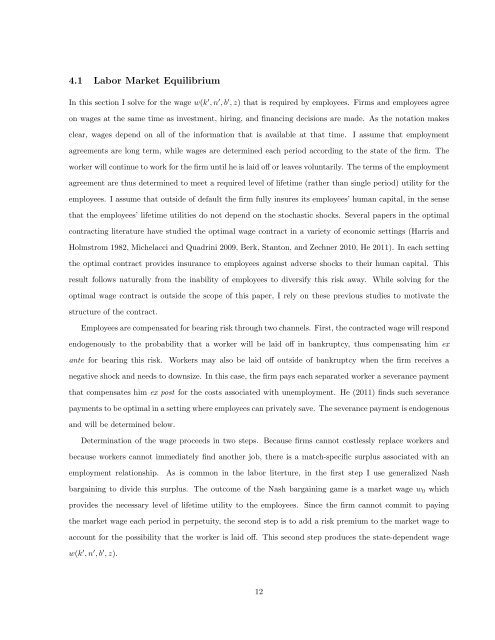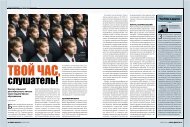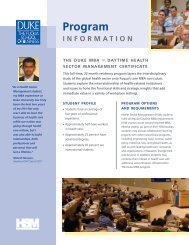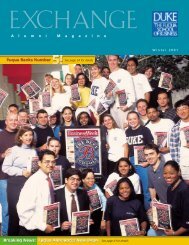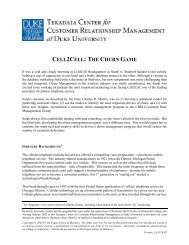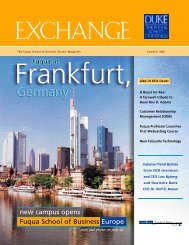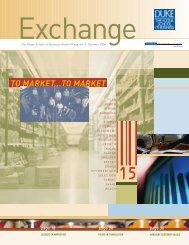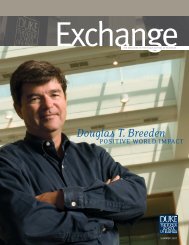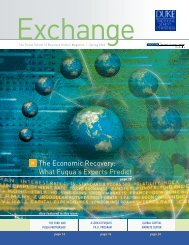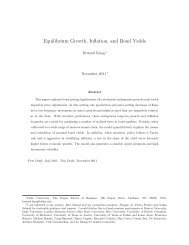A Structural Model of Human Capital and Leverage - Duke ...
A Structural Model of Human Capital and Leverage - Duke ...
A Structural Model of Human Capital and Leverage - Duke ...
You also want an ePaper? Increase the reach of your titles
YUMPU automatically turns print PDFs into web optimized ePapers that Google loves.
4.1 Labor Market Equilibrium<br />
In this section I solve for the wage w(k ′ , n ′ , b ′ , z) that is required by employees. Firms <strong>and</strong> employees agree<br />
on wages at the same time as investment, hiring, <strong>and</strong> financing decisions are made. As the notation makes<br />
clear, wages depend on all <strong>of</strong> the information that is available at that time. I assume that employment<br />
agreements are long term, while wages are determined each period according to the state <strong>of</strong> the firm. The<br />
worker will continue to work for the firm until he is laid <strong>of</strong>f or leaves voluntarily. The terms <strong>of</strong> the employment<br />
agreement are thus determined to meet a required level <strong>of</strong> lifetime (rather than single period) utility for the<br />
employees. I assume that outside <strong>of</strong> default the firm fully insures its employees’ human capital, in the sense<br />
that the employees’ lifetime utilities do not depend on the stochastic shocks. Several papers in the optimal<br />
contracting literature have studied the optimal wage contract in a variety <strong>of</strong> economic settings (Harris <strong>and</strong><br />
Holmstrom 1982, Michelacci <strong>and</strong> Quadrini 2009, Berk, Stanton, <strong>and</strong> Zechner 2010, He 2011). In each setting<br />
the optimal contract provides insurance to employees against adverse shocks to their human capital. This<br />
result follows naturally from the inability <strong>of</strong> employees to diversify this risk away. While solving for the<br />
optimal wage contract is outside the scope <strong>of</strong> this paper, I rely on these previous studies to motivate the<br />
structure <strong>of</strong> the contract.<br />
Employees are compensated for bearing risk through two channels. First, the contracted wage will respond<br />
endogenously to the probability that a worker will be laid <strong>of</strong>f in bankruptcy, thus compensating him ex<br />
ante for bearing this risk. Workers may also be laid <strong>of</strong>f outside <strong>of</strong> bankruptcy when the firm receives a<br />
negative shock <strong>and</strong> needs to downsize. In this case, the firm pays each separated worker a severance payment<br />
that compensates him ex post for the costs associated with unemployment. He (2011) finds such severance<br />
payments to be optimal in a setting where employees can privately save. The severance payment is endogenous<br />
<strong>and</strong> will be determined below.<br />
Determination <strong>of</strong> the wage proceeds in two steps. Because firms cannot costlessly replace workers <strong>and</strong><br />
because workers cannot immediately find another job, there is a match-specific surplus associated with an<br />
employment relationship. As is common in the labor literture, in the first step I use generalized Nash<br />
bargaining to divide this surplus. The outcome <strong>of</strong> the Nash bargaining game is a market wage w0 which<br />
provides the necessary level <strong>of</strong> lifetime utility to the employees. Since the firm cannot commit to paying<br />
the market wage each period in perpetuity, the second step is to add a risk premium to the market wage to<br />
account for the possibility that the worker is laid <strong>of</strong>f. This second step produces the state-dependent wage<br />
w(k ′ , n ′ , b ′ , z).<br />
12


